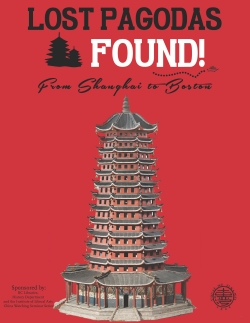In 1915, in the woodwork shop at the Jesuit-run orphanage of Tushanwan, Shanghai, Brother Aloysius Beck SJ and his young workers made 86 wooden model pagodas for the Panama-Pacific International Exhibition. This was held in San Francisco and the pagodas were shipped across the Pacific for public display. They never made it back to Shanghai, as they were then bought by representatives of the Field Museum of Natural History, Chicago, and were transported across the nation by train. The collection of elaborate and exquisite pagodas then remained at the Field for the rest of the century, sometimes on display but mostly in storage, until all but 3 of them were then re-sold to a then New York based private collector around 2008. They were then trucked to their new home and disappeared from public view. Fr. Jeremy Clarke, SJ, was asked by Chinese academic friends of his at the Tushanwan Museum to try to find out where these pagodas were. He proceeded to set this as an extended research exercise for students in his upper elective history class, “From Sun Yatsen to the Beijing Olympics”. All he told them was that these pagodas were made in Shanghai and sold in San Francisco in 1915. They were to try to track down the whereabouts of the lost pagodas by whatever means possible, but together. Through a mixture of old school archival research and extensive use of social media the students did eventually locate the missing pagodas. Lo and behold they actually found that they were all in storage in a specialized warehouse in Somerville, and throughout the month of April, three of them will be on display in the foyer of the O’Neill library.
O'Neill Level 3 Lobby Exhibit
Exhibits in O’Neill are part of the Library's educational outreach and are specifically created to stimulate interest in, and encourage further study of, the topics showcased in the displays. One case is devoted to campus events, and the remaining are open to exhibits which highlight collections, spotlight interesting research being done on campus, explore current and/or historically important events, or demonstrate cultural trends and their significance for the BC community.
Lost Pagodas Found!
March 28 – April 28, 2014

In 1915, in the woodwork shop at the Jesuit-run orphanage of Tushanwan, Shanghai, Brother Aloysius Beck SJ and his young workers made 86 wooden model pagodas for the Panama-Pacific International Exhibition. This was held in San Francisco and the pagodas were shipped across the Pacific for public display. They never made it back to Shanghai, as they were then bought by representatives of the Field Museum of Natural History, Chicago, and were transported across the nation by train. The collection of elaborate and exquisite pagodas then remained at the Field for the rest of the century, sometimes on display but mostly in storage, until all but 3 of them were then re-sold to a then New York based private collector around 2008. They were then trucked to their new home and disappeared from public view. Fr. Jeremy Clarke, SJ, was asked by Chinese academic friends of his at the Tushanwan Museum to try to find out where these pagodas were. He proceeded to set this as an extended research exercise for students in his upper elective history class, “From Sun Yatsen to the Beijing Olympics”. All he told them was that these pagodas were made in Shanghai and sold in San Francisco in 1915. They were to try to track down the whereabouts of the lost pagodas by whatever means possible, but together. Through a mixture of old school archival research and extensive use of social media the students did eventually locate the missing pagodas. Lo and behold they actually found that they were all in storage in a specialized warehouse in Somerville, and throughout the month of April, three of them will be on display in the foyer of the O’Neill library.

